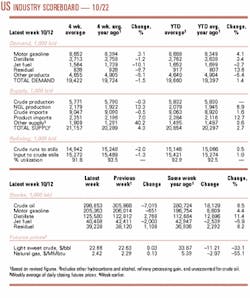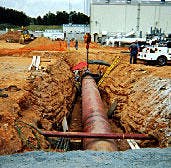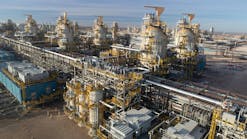Market Movement
Everything's changed for oil demand
"On the demand side, everything has changed."
With these words, IEA sums up the state of the oil market in the aftermath of the Sept. 11 terrorist attacks while noting that, on the supply side, very little has changed, as OPEC immediately pledged to keep the market adequately supplied.
IEA's estimate of oil product demand growth for 2001-now only 120,000 b/d-has been trimmed by 400,000 b/d since last month's estimates. The agency predicts that recovery of the US and global economies will now be delayed until the second half of next year at the earliest and has thus pegged 2002 oil demand growth at 600,000 b/d, down 200,000 b/d from previous estimates.
OECD demand
With the US economy most likely in a contraction already, IEA expects OECD oil demand to shrink by 1.1% in the third quarter and by 2% in the fourth.
Lower air traffic alone is predicted to reduce OECD oil demand by 175,000 b/d this year and by 220,000 b/d next year. IEA says that if the experiences of recent military campaigns in Iraq and Kosovo are a guide, then the current US and UK-led military action in Afghanistan is unlikely to have any more than a marginal effect on jet fuel demand. And as the world's economies have become more integrated, a decline in jet fuel demand in the US will probably not be offset by an up- swing elsewhere.
Decreased industrial de-mand for natural gas in North America has put downward pressure on gas prices, undermining industrial and utility demand for alternate boiler fuels in the fourth quarter of this year and the first quarter of next year. IEA forecasts that residual fuel oil deliveries will decline by 315,000 b/d, or nearly 17%, in the fourth quarter and by 245,000 b/d in the first quarter of 2002.
IEA expects the contraction in oil demand in North America and Europe to continue throughout the first half of 2002.
In OECD Asia-Pacific countries, oil demand has contracted every month since February, and the trend in the past few months points to an accelerating contraction. The Bank of Japan's most recent survey of business executives indicates a dramatic drop in business confidence, and Japan's refiners are bracing for lower demand by decreasing throughputs as much as 6% year-on-year in the fourth quarter.
Non-OECD demand
Non-OECD economies will also feel the effects of the worsening US slowdown. But price reductions resulting from the economic toll of the Sept. 11 attacks could lead to an increase in demand in developing countries, where diesel and gasoline consumption previously had suffered under high prices. Oil producing economies, however, could see their domestic oil demand falter if lower oil prices and a weaker US dollar erode revenues.
The downturn in the global economy has made China the world's leading demand growth market in percentage terms, says IEA, especially following the September attacks. Domestic demand has been bolstered in part by investments prior to China's entry into the World Trade Organization and will continue to be strong following Beijing's selection to host the 2004 Olympics. The agency expects oil demand growth in China next year to reach 3.3%. At 160,000 b/d, China's growth in terms of volume would be second only to North America.
null
null
null
Industry Trends
FINDING AND DEVELOPMENT cost increases in the Western Canadian Sedimentary Basin were driven by strong gas drilling and strong oil production replacement rate but were offset by higher input costs, according to Ziff Energy Group.
Ziff said that its 2001 F&D cost study offers a "comprehensive assessment of the longer-term efficiency and effectiveness of exploration and development spending at a strategy level" in the WCSB.
Ziff reported that drilling activity in 2000 was driven by high product prices and rising cash flows: "As commodity prices rebounded from the lows in the late 1990s, so did activity levels. While activity grew, so did the industry average F&D cost, which rose in 2000 to $8.60 (Can.)/boeellipseup from 1999 (see table)," the analyst said.
In addition, Ziff noted that medium and deep gas drilling activity in 2000 rose by 30% compared with a year ago, while shallow gas drilling maintained steady growth as well. Drilling for heavy oil, meanwhile, increased by 114%.
Notably, production replacement of oil "jumped significantly" in 2000-to 154% from 86% in 1999, Ziff said. "While below the highs of 178-201% in 1996-97, this is the third highest replacement in the last 8 years and reversed the negative trend of 1998-99," the consultant said.
SMALL MARKET CAPITALIZATION exploration and production companies will likely report a decrease in earnings per share of 47% vs. second quarter levels and a decline of 41% vs. a year ago, according to a forecast by Lehman Bros. analyst Jeffrey Robertson. The decrease will likely be driven mainly by lower natural gas prices, the analyst said.
"Natural gas prices are 32% lower than the prior year's level, as increasing natural gas production and falling demand have caused prices to trend lower over the course of the year," Robertson noted.
Throughout the year, E&P firms have increased their exploration and development budgets to meet higher activity levels, higher service costs, and asset acquisitions (see related story, p. 60). Based on its NYMEX reference price estimates of $2.00/MMbtu and $26/bbl for the fourth quarter-which are a decrease of 62% and 18%, respectively, from a year prior-the analyst said that aggregate expenditures presently surpass estimated discretionary cash flow by 19%.
This decline in gas prices, Robertson said, should cause E&P firms to use a "lower price deck" when outlining their drilling programs for 2002.
"We estimate that this lower level of drilling activity could underpin a potential rebound in natural gas prices during the second half of 2002," Robertson said.
Government Developments
CHINA amended its oil and gas legislation earlier this month to allow Sinopec to invite foreign exploration and production companies to bid for onshore oil and gas blocks. Under the previous law, only China National Petroleum Corp. had that right.
The new regulation allows only CNPC and Sinopec to buy equity oil from foreign companies operating under production-sharing contracts in China.
In another new regulation, the government confirmed CNOOC's exclusive responsibility for exploring offshore petroleum resources in China in cooperation with foreign enterprises.
The government also named China United Coal-Bed Methane Co. as the exclusive entity to engage with foreign companies in cooperative exploration and production of coalbed methane.
THE AMERICAN GAS ASSOCIATION'S recent announcement to discontinue its weekly report on working natural gas effective Jan. 2 had industry speculating over possible cause and effect scenarios as a result of the change (see Watching Government, p. 30).
Marshall Adkins, managing director, energy equity research, for Raymond James & Associates noted AGA had to revise one of its estimates several months ago (OGJ, Aug. 27, 2001, Newsletter, p. 5).
"They're probably dropping it because of the combination of the high cost of doing it weekly and the amount of grief they were getting from people. This is a report everyone looked for every single Wednesday. Without it, there surely will be a lot more volatility because you're taking a key weekly data point away from the market."
Ed Krapels, director, gas and power services, for Energy Security Analysis Inc., said, "I presume EIA will be willing to issue their data more frequently.
"It would be a terrible problem for the industry if EIA didn't take up the report. In the oil sector, we've had the weekly EIA and American Petroleum Institute data for many years, one following the other, so there's no doubt EIA could do it. I hope they will."
THE UK GOVERNMENT has ordered a review of all energy research, development, and demonstration activities.
David King, the government's chief scientific adviser, will head the evaluation of the level of expenditures on energy related activities, how spending is targeted, and where the gaps exist.
Commenting on the review, King said, "We need clean efficient energy for our industries, our houses, our work places, for transport, and for leisure. Science can provide the novel directions we need. More top scientists and technologists should be encouraged to develop and improve clean energy sources and find means of increasing the efficiency with which these sources are used.
The conclusions of the review will be fed into the review that the government's Performance and Innovation Unit is conducting of UK energy policy.
Quick Takes
RasGas LNG plant in Qatar. Photo courtesy of Mobil Corp.
QATAR's RASGAS has awarded a Technip-Chiyoda joint venture a 100 million euro contract to expand the Ras Laffan LNG plant on the northeastern coast of Qatar.
The JV will conduct detailed engineering, procurement, and construction for the debottlenecking of three LNG trains.
The work in- volves replacing or upgrading compressors and turbines to expand the capacity of each train to 3 million tonnes/year from 2 million tonnes. Work will be performed during four 1-month shutdowns scheduled during 2002-05.
Elsewhere in LNG developments, FERC has given the nod to Williams to reactivate import facilities at its Cove Point LNG terminal in Lusby, Md. That terminal operated during 1978-80 and was partially reactivated in 1995 to provide natural gas peaking services. The reactivation plan includes renovations to pier facilities, construction of a fifth storage tank, and construction of a btu-reduction system (OGJ Online, Jan. 31, 2001). Construction will boost Cove Point's storage capacity to 7.8 bcf from 5 bcf. Reactivation of the import service is slated for second quarter 2002, and the fifth storage tank is expected to be operating in third quarter 2003.
Royal Dutch/Shell is expected to become the first user of heat exchange technology that was jointly developed by Statoil and Linde. Shell plans to use part of the technology in its North West Shelf LNG project in Karratha, Australia. Statoil and Linde developed the technology for the Sn hvit LNG project on Melk ya, off Hammerfest, Norway. Statoil executives say the Australian installation of the technology will become operational before Sn hvit. The technology includes spool-wound heat exchangers that are part of the process of cooling down the gas to -163° C, which is the temperature at which the gas converts to a liquid.
KVITERJØRN gas-condensate field development is progressing off Norway.
Statoil has signed well services contracts that will total 400 million kroner, providing that all 11 of the planned wells are drilled in the North Sea field.
The Kvitebjørn development is technologically demanding because the reservoir is under high pressure and high temperature. Four of the 11 wells are expected to be operating in autumn 2004.
Statoil has 50% interest in Kvitebjørn. The Norwegian state's direct financial interest is 30%. The other licensees are Norsk Hydro 15% and TotalFinaElf 5%.
Schlumberger Oilfield Services will provide directional drilling, logging while drilling, mud logging, and electrical logging.
Halliburton will supply drilling fluids and cementing services. Baker Oil Tools will provide downhole completion services and install tools in the wells. Prosafe will provide production drilling and will maintain the drilling package.
In other development action, Petrobras has awarded a unit of FMC Technologies an $18 million contract to supply subsea facilities for Albacora Leste field in the Campos basin off Brazil. FMC will supply three subsea water injection manifolds, two subsea trees, and associated control systems. Delivery is slated for early 2003. Petrobras and 10% partner Repsol-YPF will invest $1.7 billion to develop the field (OGJ Online, May 25, 2001). In 2003, the partners expect production of 34,000 b/d of crude and 400,000 cu m/day of gas, expandable to 180,000 b/d and 2.25 million cu m/day by 2009. Upon completion of the contract, FMC will have delivered 15 subsea manifolds to Petrobras.
QATAR PETROLEUM has signed a preliminary deal for construction of what could eventually become the world's largest ethane cracker.
The 1 million tonne/year plant at Ras Laffan is expected to come on stream in second half 2006. If expanded by 500,000 tonnes/year in the second phase, sponsors said it would be the largest such unit in the world.
QP expects contract finalization later this year. Partners will be QP, Chevron Phillips Chemical, Chevron Phillips International Qatar Holdings, Atofina, and QP unit Qatar Petrochemical Co. (QAPCO).
QP and Chevron Phillips previously announced a JV agreement for a combined ethylene and polyethylene project (OGJ Online, June 25, 2001). The latest deal makes Atofina and QAPCO equity participants in the ethane cracker.
The cracker will provide feedstock via pipeline to new polyethylene plants at Ras Laffan and at Mesaieed.
Elsewhere on the petrochemicals front, Shell Chemical awarded Halliburton unit Kellogg Brown & Root a contract to debottleneck its olefins plant in Deer Park, Tex. Work will include integrated engineering, procurement, construction, and maintenance services on a steam cracker. The $400 million project is expected to boost Shell's ethylene capacity at the plant by 1.1 billion lb/year, bringing production to 3.1 billion lb/year. The expansion is scheduled to come on stream in 2003.
PETROBRAS is considering how it might acquire refining capacity abroad.
The acquisition might involve US refining capacity, said Petrobras Pres. Henri Reichstul. He emphasized Petrobras is looking for additional capacity but is not necessarily planning to buy a refinery.
Several alternatives are being evaluated, including renting idle capacity in another company's refinery. No decision has been reached, Reichstul said (OGJ Online, Oct. 16, 2001). Petrobras owns 11 of Brazil's 13 refineries.
In other refining news, PetroChina unit Jinzhou Petrochemical has begun building a jet fuel hydrotreater in northeastern China's Liaoning Province. The 400,000 tonne/year unit at the 110,500 b/d Jinzhou refinery is expected to be completed in October 2002. The $7.85 million project is part of PetroChina's plan to make Jinzhou one of its four refining centers by 2005. The other three will be at Fushun City and Dalian City, both in northeastern China, and at Lanzhou City in the northwest. Jinzhou currently operates a 600,000 tonne/year diesel and gasoline hydrotreating unit.
INDIA'S OIL & NATURAL GAS CO. is negotiating participation in 14-15 oil exploration properties abroad.
ONGC Videsh was investigating projects in Iraq, Algeria, Myanmar, Indonesia, Nepal, Libya, Iran, Russia, Venezuela, the UAE, Sudan, and Viet Nam.
Recently, the Reserve Bank of India approved ONGC's plan to invest $5 million in exploration in Iraqi Block 8. ONGC is preparing a proposal for a seismic survey of Block 8, although investment by foreign companies in Iraq's oil sector is currently banned under international sanctions.
In partnership with Reliance Industries of India and Algerian national oil firm Sonatrach, ONGC also was drafting a contract for participation in an Iraqi oil and gas field at Tuba, pending the lifting of sanctions.
ONGC has a tentative agreement for Algerian Block 242, is bidding for a block in Iran, and is negotiating with Pertamina for participation in the Aru-Langkat block in Indonesia.
It is also examining participation in Texana Block in Nepal, the Tpao block in Libya, several oil fields in the Timan-Pechora basin of Russia, and a block in Lake Maracaibo in Venezuela.
ROCKY MOUNTAIN GAS (RMG) and partners have completed 20 coalbed methane (CBM) wells in Wyoming and plan to drill up to 25 more this fall.
Of the total, 16 wells are on Clearmont, Wyo., area CBM properties, and 4 wells are in the Frontier and Adaville coal seams on the Oyster Ridge project.
The Oyster Ridge project covers 63,000 acres in southwestern Wyoming in Ham's Fork coal field adjacent to the Green River basin. RMG owns 100% of the project, which is subject to a 25% participation option held by Anadarko. The Kern River pipeline crosses the property.
RMG and a unit of Carrizo Oil & Gas are completing two more wells at the 6,000 acre Clearmont project in the Powder River basin. They have installed submersible pumps on six wells as part of the dewatering process and plan to place more wells on pump (OGJ Online, July 10, 2001). F
Tipperary inked a deal to sell CBM to Australian company Queensland Fertilizer Assets. At current exchange rates, the deal is worth at least $300 million. Queensland Fertilizer agreed to buy up to 260 bcf of CBM over 20 years beginning in 2004 for use in a fertilizer plant that it plans to build in southeastern Queensland. Construction of the plant should begin 6 months after Queensland Fertilizer obtains regulatory approval and financing and should take 2 years. Tipperary Oil & Gas (Australia) owns a 65% interest in the Comet Ridge CBM project. It will offer each project participant a portion of sales under the fertilizer company contract.
WILLIAMS GAS PIPELINE has started work on its Sundance expansion project, which includes the retrofit and expansion of four pipeline compression stations in the southeastern US. .
Service is expected to begin in May 2002. The expansion will increase system capacity by 236,000 dekatherms/day.
Paragon Engineering Services is providing the engineering, design, and procurement services, while Sunland Construction has overall contract responsibility and project construction.
The four Williams compression stations will tie into a 30 in. pipeline and a 36 in. pipeline on the Transco Pipeline System, which extends 1,800 miles from South Texas to New York.
In other pipeline happenings, the Mac-kenzie Delta Producers Group signed a memorandum of understanding with the Northwest Territories' indigenous peoples that provides a framework to develop the proposed Mackenzie Valley gas pipeline in Canada. Imperial Oil leads the four-member consortium, which includes Conoco Canada, Shell Canada, and ExxonMobil Canada. The producers are studying the feasibility of a $3 billion (Can.) line with initial capacity of 800-1,000 MMcfd. They estimate existing discoveries have 5.8 tcf of reserves. Imperial said the MOU specifically does not apply to a transportation system that includes Alaskan gas. The agreement had support from the Deh Cho First Nation of Fort Liard, which previously had refused to sign a pipeline development agreement approved by five other First Nation groups (OGJ Online, June 12, 2001).
Western Gas Resources and Questar Market Resources subsidiaries have formed a JV to provide gas gathering and compression services in southwestern Wyoming. The JV, Rendezvous Gas Services, will construct and operate gas pipeline and compression facilities with the capacity to move 275 MMcfd of gas from the Hoback basin, which includes Pinedale Anticline and Jonah fields. Rendezvous plans to spend $15.5 million for an initial phase of pipeline and compression expansions starting late this year. A second, $28 million expansion phase is being evaluated. Construction is slated to begin in mid-2002.
Reef Marketing, a unit of Tidelands Oil & Gas, signed an initial 10 year agreement to sell natural gas to Conagas, a distribution company that serves the Piedras Negras, Coahuila, Mexico, area. The gas, provided by Tidelands and third parties, will be moved through a 12 in. pipeline to be built underneath the Rio Grande River. Tidelands did not disclose the volume of gas involved or the worth of the 10 year Conagas agreement. Contract terms call for Tidelands to process gas at its Rio Bravo processing plant and transport it via its Sonora Pipeline network to the proposed Eagle Pass-Piedras Negras international pipeline crossing. The Texas Railroad Commission recently granted operating and construction permits to Reef International, another Tidelands subsidiary, to begin construction of that international pipeline crossing on the US side of the Mexican border. The proposed line would transport natural gas, propane, and butane at the same crossing via a three-line network (OGJ Online, Oct. 9, 2001). The international crossing is in its final permitting phase and is expected to be operational by early 2002.








